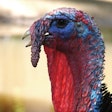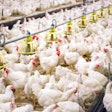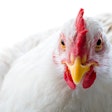
The Pirbright Institute in the United Kingdom (U.K.) has made a breakthrough for the development of a vaccine that can protect poultry simultaneously from both avian influenza and Marek’s disease.
According to scientists there, this application of a genetic engineering technique will allow animal health companies to update vaccine strains more quickly. Until now, the rapid evolution of the avian flu virus has been a significant challenge to the development of effective vaccines.
“Improving how we make vaccines is critical for preventing avian influenza outbreaks,” said Professor Munir Iqbal, head of the avian influenza group at the institute. “Our work could help reduce the spread of disease between birds, and reduce the risk of infection for people who work closely with poultry.”
The technique used by the group is described in a paper published in the journal Vaccines. In essence, the Pirbright team inserted a gene into the turkey herpesvirus that is already used as the basis for Marek’s disease vaccine. The inserted gene codes for hemagglutinin (HA). HA is an influenza protein that allows the virus to enter the host’s cells. This makes it an important target of the bird’s immune response to block infection.
The next step will be to study the vaccine’s efficacy in field trials, said Iqbal.
Two more outbreaks in Taiwan poultry
Two further outbreaks of highly pathogenic avian influenza (HPAI) have been detected in Taiwan over the past two weeks.
According to Focus Taiwan, these involved flocks 1,862 geese and 3,114 turkeys in Chiayi County. HPAI virus was detected in the geese — which were around one year old — after the farmer noted a drop in egg-laying and an increase in mortality. The virus was not identified beyond being an H5 HPAI type. The H5N2 virus variant was confirmed in the turkey flock.
Both flocks have been destroyed, and nearby farms are being tested for the presence of the HPAI viruses.
Nigeria clarifies outbreak as HPAI
Recently the federal agriculture ministry in Nigeria officially reported an outbreak of low-pathogenic avian influenza (LPAI). According to the latest ministry report to the World Organisation for Animal Health (OIE), further testing of the virus has revealed the virus to be highly pathogenic.
The virus — an H5N6 variant — was detected as the result of active surveillance in 150 birds out of more than 2,400 at a live bird market in Sokoto in June of 2019. This was the first time this variant had been detected in Nigeria. Sokoto is in the north-west of the country, and borders Niger.
Since 2015, the ministry has confirmed the H5N1 HPAI virus at a number of locations. A highly pathogenic H5N8 subtype was last reported at a live bird market in the southern state of Edo during April 2019.
Further LPAI cases in Dominican Republic
In the past two weeks, the agriculture ministry in the Dominican Republic has reported to the OIE a further 12 outbreaks of LPAI. An H5N2 variant was detected at the poultry units in the states of Espaillat, La Vega, and Santiago between February 2 and August 31, 2019.
One of the affected flocks was a backyard with fighting cocks, but the other outbreaks were on farms with 5,000-51,000 layers, broilers, or breeders. In total, more than 224,000 poultry were affected, almost 14,000 of which died. Around 3,300 birds were destroyed.
Since the virus was first detected in a backyard flock in the Caribbean state in early November of 2018, there have been 30 confirmed outbreaks of disease linked to the virus. The number of poultry involved has reached almost 860,000.
Chile resolves LPAI situation
Chile’s agriculture ministry has reported to the OIE that the previous LPAI situation has been “resolved.”
LPAI virus of the H7N6 subtype was first detected in a flock of fattening turkeys at the end of August 2019, according to official report to the OIE. The farm was located in the region of Valparaiso in central Chile. Source of the infection remains unknown.
In all, more than 106,000 birds — all fattening turkeys — were found to be infected with the virus at four locations, all in the same region. The most recent outbreak was in mid-October. All surviving birds were destroyed, and the premises cleaned and disinfected. Latest environmental samples taken from the affected farms all tested negative for the virus.
All four infected turkey flocks belonged to one company, according to the agriculture ministry (SAG).
SAG’s director thanked ministry officials, the Valparaiso livestock team as well as local professionals and support workers for quickly addressing and controlling the health emergency.
If there are no further outbreaks, Chile can be declared avian influenza-free again on March 17, 2020, according to SAG.
Recently reported cases of avian influenza (A) in humans
In its most recent report dated November 25, the World Health Organization (WHO) outlines three cases of avian influenza(A), all in young children and linked to the H9N2 virus variant.
Two of the cases were in China in the provinces of Fujian and Anhui in October and November of 2019. One of these children—aged 4 and 5 years—had contact with backyard poultry, and the other with a poultry slaughterhouse.
WHO has recently been informed about the third human case. This was in India’s Maharashtra state, in a younger child who became ill in January of 2019.
View our continuing coverage of the global avian influenza situation.















